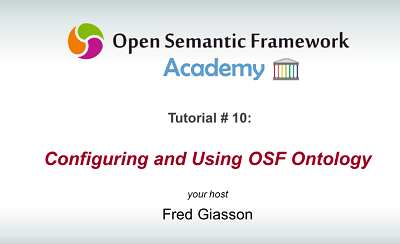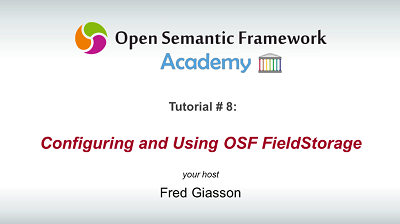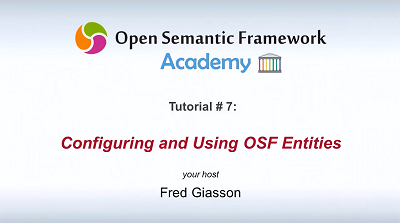| Structured Dynamics is happy to announce the immediate availability of the Open Semantic Framework version 3.3. This new release of OSF lets system administrators choose between two different communication channels to send SPARQL queries to the triple store: |  |
- HTTP
- ODBC
In OSF 3.1, the only communication channel available was a ODBC channel using the iODBC drivers. In OSF 3.2, the only communication channel available was a HTTP channel. What we did with OSF 3.3 is to let the system administrator choose between the two.
Quick Introduction to the Open Semantic Framework
What is the Open Semantic Framework?
The Open Semantic Framework (OSF) is an integrated software stack using semantic technologies for knowledge management. It has a layered architecture that combines existing open source software with additional open source components. OSF is designed as an integrated content platform accessible via the Web, which provides needed knowledge management capabilities to enterprises. OSF is made available under the Apache 2 license.
OSF can integrate and manage all types of content – unstructured documents, semi-structured files, spreadsheets, and structured databases – using a variety of best-of-breed data indexing and management engines. All external content is converted to the canonical RDF data model, enabling common tools and methods for tagging and managing all content. Ontologies provide the schema and common vocabularies for integrating across diverse datasets. These capabilities can be layered over existing information assets for unprecedented levels of integration and connectivity. All information within OSF may be powerfully searched and faceted, with results datasets available for export in a variety of formats and as linked data.
Why Multiple Channels in OSF?
Historically, OSF only used the ODBC channel to communicate with Virtuoso, and it was using the iODBC drivers. As explained in a previous blog post, the fact that we were using the iODBC drivers in Ubuntu was adding a lot of complexity into the system since we had to recompile most of the PHP packages to use that other ODBC driver.
With OSF 3.2, we refactored the code such that we could query any SPARQL HTTP endpoint. The goal of this current improvement is to be able to use any triple store that has a compatible SPARQL HTTP endpoint with OSF, and not just Virtuoso.
With OSF 3.3, what we choose to do is to make both options a possibility. However, what we did is to make sure that the latest version of Virtuoso was now properly working with the unixODBC drivers, which are shipped by default with Ubuntu.
This means that people can now use the ODBC channel, but using the unixODBC drivers instead. The end result of this enhancement is that it makes the maintenance of a Ubuntu/OSF instance much easier since no packages are on hold, and that the PHP5 packages can be updated at any time without needing to be recompiled using the iODBC drivers.
Deploying a New OSF 3.3 Server
Using the OSF Installer
OSF 3.3 can easily be deployed on a Ubuntu 14.04 LTS server using the osf-installer application. The deployment is done by executing the following commands in your terminal:
[cc lang=”bash”]
[raw]
mkdir -p /usr/share/osf-installer/
cd /usr/share/osf-installer/
wget https://raw.github.com/structureddynamics/Open-Semantic-Framework-Installer/3.3/install.sh
chmod 755 install.sh
./install.sh
./osf-installer –install-osf -v
[/raw]
[/cc]
Using an Amazon AMI
If you are an Amazon AWS user, you also have access to a free AMI that you can use to create your own OSF instance. The full documentation for using the OSF AMI is available here.
Upgrading Existing Installations
It is not possible to automatically upgrade previous versions of OSF to OSF 3.3. It is possible to upgrade an older instance of OSF to OSF version 3.3, but only manually. If you have this requirement, just let me know and I will write about the upgrade steps that are required to upgrade these instances to OSF version 3.3.
Conclusion
This new version of the Open Semantic Framework should be even simpler to install, deploy and maintain. Several additional small updates have also provided in this new version to other aspects of installation simpler and faster.



